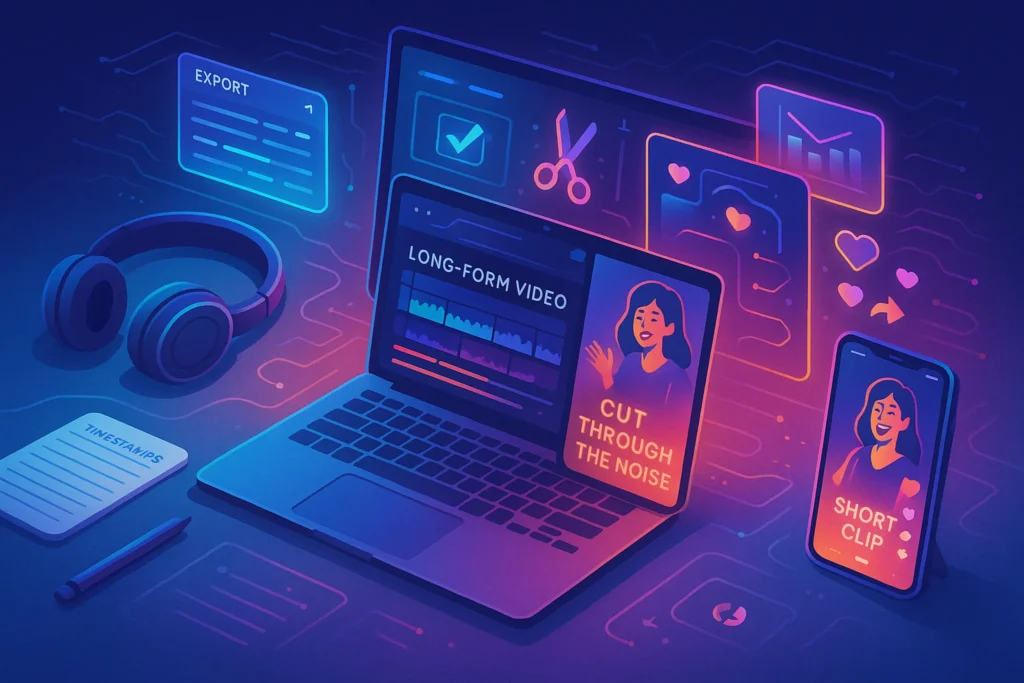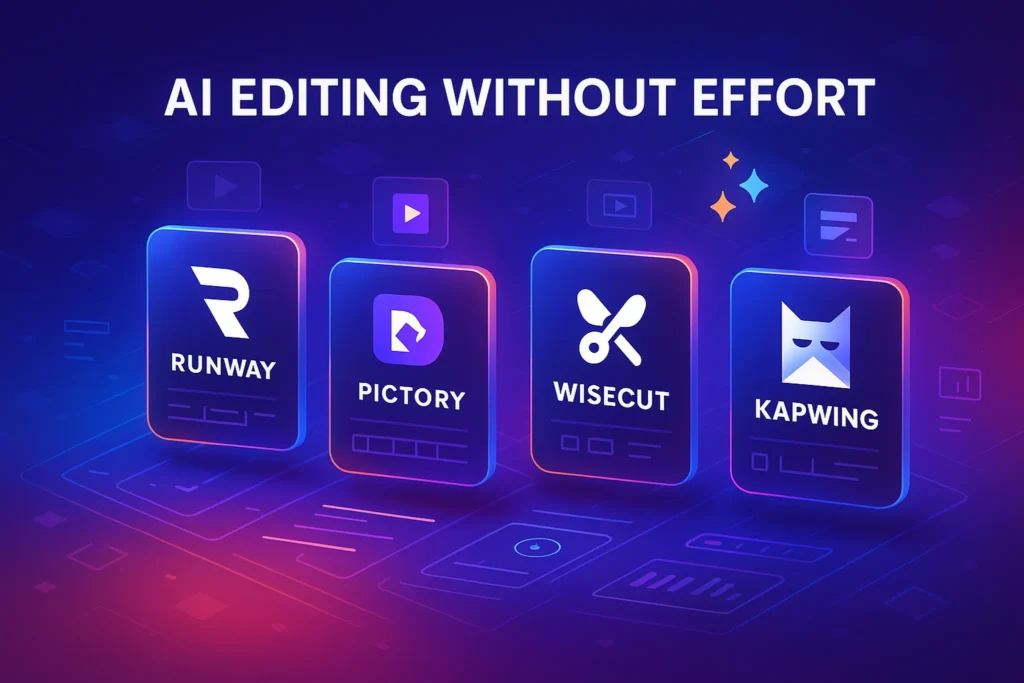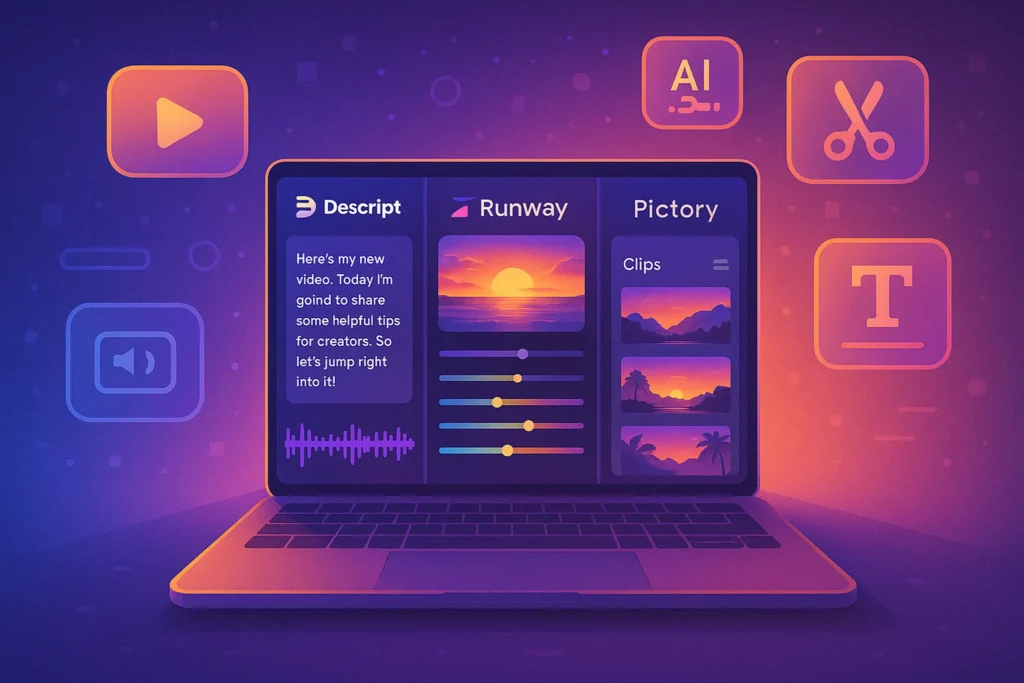Introduction: The New Attention Economy
In the past, long-form videos were the crown jewel of content strategy. Creators would invest weeks scripting, filming, and editing a single 45-minute webinar or documentary-style piece, expecting that depth alone would guarantee attention. That was before the explosion of short-form platforms like TikTok, Instagram Reels, and YouTube Shorts — channels built for quick consumption and viral momentum.
Today, the way audiences discover creators has changed. A great 60-minute interview might only reach a fraction of its potential if it lives on one platform in its entirety. But when you extract the most compelling, high-energy moments and transform them into short clips, you create doorways into your content universe. These clips aren’t “lesser” versions of the original — they are precision-cut highlights designed to grab attention, build curiosity, and invite viewers into the full story.
Consider how a single insight from a video — like a guest revealing a zero-cost marketing tactic that doubled their traffic — can stand alone as a 20-second Short. That moment can rack up thousands of views, get shared across social media, and push intrigued viewers toward your complete guide, whether that’s a YouTube video, podcast episode, or in-depth article such as our breakdown of Video Marketing Trends for 2025.
This is the reality of the attention economy: people will give you 15–30 seconds if you earn it, and those seconds are often the bridge to deeper engagement and loyalty. Repurposing is how you make that bridge stronger, wider, and more profitable.
Why Repurposing Works
The logic behind repurposing is deceptively simple: you’ve already done the hard work of creating rich, valuable content. Every edit, every insight, every frame is already there. The problem is discoverability. Platforms don’t always promote long-form content to cold audiences. Short clips, however, fit perfectly into the algorithm’s hunger for engagement spikes and quick watch completions.
Short-form clips are easier for people to consume during micro-moments — on a coffee break, in the commute queue, or while scrolling before bed. They also multiply your surface area in the digital landscape. Instead of one video fighting for attention, you have multiple touchpoints, each crafted to appeal to a slightly different audience segment or curiosity trigger.
When done well, repurposing also improves your brand consistency. Viewers see multiple clips with your style, tone, and value proposition, reinforcing familiarity. And in marketing, familiarity breeds trust — the kind of trust that moves someone from passively watching to actively subscribing, visiting your site, or purchasing a product you recommend.
A creator we worked with used this exact strategy: from a single deep-dive on How to Create Viral Video Content, they extracted six shorts. Two were comedic reactions, two were quick tactical tips, and two were “myth-busting” moments. Collectively, those shorts drove over 18,000 additional clicks to the full video and tripled email sign-ups that month.
Case Study: From Webinar to Viral Clips
A fitness coach hosted a 45-minute live Q&A session on YouTube. Attendance was decent — about 120 live viewers — but post-event replay views plateaued after the first week. Rather than letting the content fade, she identified five moments where the audience reacted most strongly. These included a “30-second morning stretch challenge” demonstration, a motivational story, and a surprising debunking of a common diet myth.
Each clip was edited to fit a vertical 9:16 frame, with captions styled in her brand colors. She ended each one with a soft call-to-action: “Watch the full Q&A for all my tips — link in bio.” Clips were published in a staggered schedule across TikTok, Instagram Reels, and YouTube Shorts.
Within two weeks:
-
TikTok delivered one breakout clip at 48,000 organic views.
-
Instagram Reels brought 2,100 new followers.
-
YouTube Shorts increased the original video’s watch time by 37%.
The lesson is clear: repurposing isn’t about recycling for the sake of filling a feed. It’s about distilling a concentrated dose of value and placing it where new eyes are most likely to find it.
Identifying Key Moments
Not every part of a long-form video makes a good short. The magic lies in pinpointing moments that can stand alone without losing their punch. This means looking for self-contained insights, emotional beats, or visual elements that will hook someone even if they have zero context.
A practical starting point is your analytics. On YouTube, Audience Retention graphs will show where viewers are most engaged or rewatch sections. These peaks are often goldmines. On other platforms, review comment timestamps or note where live audiences interacted most in chat.
Another highly effective approach is transcript analysis. Using tools like Otter.ai or Descript, you can scan the entire conversation for “quote-worthy” lines or intriguing story beats. If a single sentence makes you think, “That could be a tweet,” it probably has short-form potential.
Don’t ignore visual cues. A dramatic reaction, a surprising screen share, or a rapid transformation shot can capture attention in milliseconds. For instance, if your guest demonstrates a DIY Lighting Hack live, that’s a segment that not only works as a short but can naturally drive viewers to your dedicated post on DIY Lighting Hacks for Professional Looking Videos.
The key is to remember that short clips aren’t summaries — they’re teasers designed to spark curiosity and create a path to the full content.
Editing for Impact
Once you have the right moment, the edit determines whether it becomes a scroll-stopper or gets lost in the feed. For vertical-first platforms, framing is non-negotiable. Crop to 9:16 and center key subjects so they remain visible even on smaller screens.
Pacing matters just as much as framing. Trim silences, filler words, and tangents. Use tight cuts to maintain momentum. If your moment involves a complex idea, consider adding subtle text overlays or B-roll footage to maintain visual interest while clarifying the point.
Don’t underestimate the power of on-screen hooks. The first 2–3 seconds decide whether viewers stay. Use bold captions like “This is why your videos aren’t getting views…” or “The $50 hack that makes you look pro.” Keep them large enough to be readable without overwhelming the frame.
Finally, think of the end of your clip as a launchpad. A visual or verbal CTA like “Full tutorial on our channel” is subtle but effective, especially if paired with a consistent branded outro. If you already have a resource like YouTube Shorts vs TikTok vs Reels, this is a perfect place to reference it for viewers deciding where to focus their short-form strategy.
Captions & Subtitles
Captions are no longer optional. With over 80% of mobile video watched without sound, they’re an accessibility feature, an engagement booster, and a retention tool all in one. But captions can be more than functional — they can be part of your storytelling.
Burn-in captions ensure they display regardless of platform settings. Style them to match your brand identity: use contrasting colors, emphasize keywords with a different shade, and place them where they won’t obscure key visuals. This doesn’t just help comprehension; it guides the viewer’s eye and emphasizes the most impactful words.
Tools like Descript allow you to edit video by editing the transcript — perfect for quickly removing “ums” and awkward pauses while generating captions. CapCut’s mobile-friendly editor offers trendy caption styles that perform well on TikTok and Reels, while Rev.com provides human-verified accuracy for content where precision is critical.
🎬 Want More Smart Video Strategies Like This?
Join our free newsletter to get weekly insights on video content trends, repurposing workflows, and creator tools—delivered straight to your inbox.
No spam. Just actionable tips to grow your brand with smart content.
🔐 100% privacy. Zero noise. Only high-quality insights from the NerdChips team.
Extra Tools for Analysis & Clip Ideation
Beyond editing tools, creators can benefit from platforms that make finding the right moments easier. VidIQ and TubeBuddy offer deep YouTube analytics, including retention curve overlays and competitive benchmarks. This helps you identify not only your own best moments but also patterns from top-performing competitors.
Otter.ai automatically transcribes audio, making it easy to scan for potential highlights or export text for captioning. Descript, as mentioned, bridges the gap between text and video editing, letting you cut footage like you would delete words from a document.
For organizing your workflow, project management tools like Notion or Trello can help schedule clip releases, track performance, and even store reusable caption templates. This kind of structured approach turns repurposing from a one-off tactic into a repeatable system — something we also discuss in our content planning framework inside How to Create Viral Video Content.
Common Mistakes to Avoid
Even the best repurposing plans can fail if execution falls into certain traps. One common mistake is pulling a clip that relies too heavily on context from the longer video. If a new viewer needs background to understand what’s happening, the clip will likely underperform. Each short should stand on its own, delivering value, insight, or entertainment without explanation.
Another mistake is neglecting the hook. The first three seconds are make-or-break. If your short opens with a slow greeting, you’ve lost the chance to stop the scroll. Instead, lead with a statement, a surprising fact, or a visually interesting action.
Over-editing is also an issue. Excessive transitions, filters, or sound effects may look flashy but can overshadow your message. Remember, in short-form content, clarity beats complexity. Finally, failing to tailor clips to each platform can waste potential reach. TikTok, Reels, and Shorts may share a vertical format, but their audiences and cultures differ. What goes viral on TikTok may not resonate on YouTube Shorts without some adaptation in pacing or caption style.
Content Recycling Calendar
One of the easiest ways to make repurposing sustainable is to treat it like a production line. For example, after publishing a long-form video on Monday, Tuesday could be dedicated to identifying and editing your top three moments. Wednesday and Friday, you release the first two clips. The following week, you release the remaining clips, perhaps with a “best moments” compilation on the weekend.
This approach ensures your audience is consistently reminded of your main content without feeling bombarded. It also means you’re extracting maximum value from each recording session. Over time, this rhythm becomes predictable for both you and your viewers, which can help with engagement and retention.
Comparison Table: Short-Form Platforms in Context
While all short-form platforms share certain traits, their algorithms, audience behaviors, and content lifespans vary. TikTok is optimized for rapid discovery and trend participation, making it a great testing ground for creative hooks. Instagram Reels benefits from integration with Stories and the Explore feed, offering both quick bursts of engagement and moderate content lifespan. YouTube Shorts, on the other hand, ties directly into your main channel ecosystem, often driving sustained traffic to long-form content over weeks rather than days.
| Platform | Algorithm Boost Factor | Content Lifespan | Avg Engagement Rate | Best Clip Length |
|---|---|---|---|---|
| TikTok | High for trends & early views | 2–5 days | 5–9% | 15–30 sec |
| Instagram Reels | Medium, boosted via Stories | 3–7 days | 3–6% | 15–30 sec |
| YouTube Shorts | Medium-high, links to channel | 7+ days | 4–7% | 15–60 sec |
Distribution Strategy
Publishing your clips is just the start. The distribution plan determines whether they disappear in the scroll or continually drive engagement. Always publish natively on each platform to benefit from its algorithm. TikTok rewards content that matches trending sounds and hashtags relevant to your niche. Instagram Reels performs best when paired with engaging Stories content that drives traffic to the Reel. YouTube Shorts should be optimized with keyword-rich titles and descriptions that point directly to the full video.
Cross-promotion is your secret weapon. A TikTok clip can be reposted to Instagram Reels with slight caption tweaks, while Shorts can be embedded into your related blog posts — for instance, embedding a relevant short into How to Create Viral Video Content keeps readers on-page longer and exposes them to your video content.
🧠 Nerd Verdict
Repurposing is one of the most efficient, high-leverage moves you can make as a video creator. It’s not about squeezing every second from your footage; it’s about identifying and amplifying the moments most likely to hook a new viewer. In an era where attention is fragmented and competition is fierce, your ability to extract, refine, and distribute these highlights will often determine the difference between a stagnant channel and a growing brand.
❓ FAQ: Nerds Ask, We Answer
💬 Would You Bite?
What’s the one long video in your archive right now that’s begging to become your next viral short?



